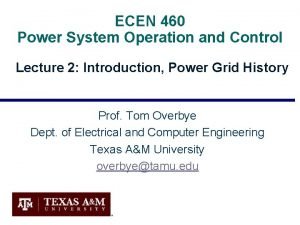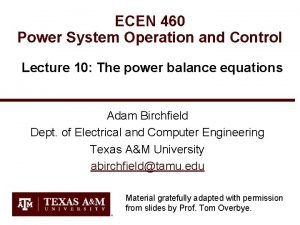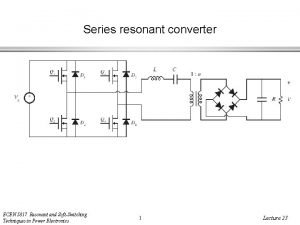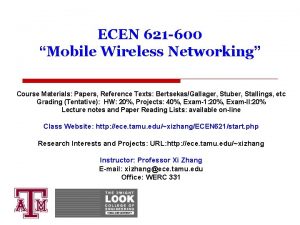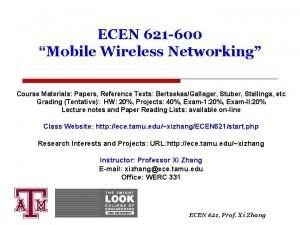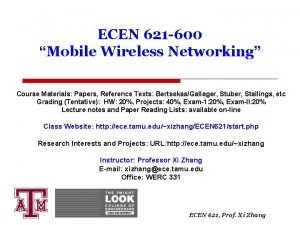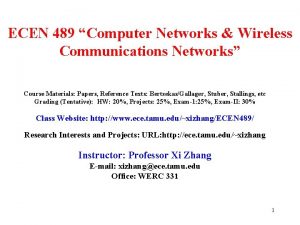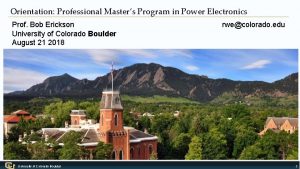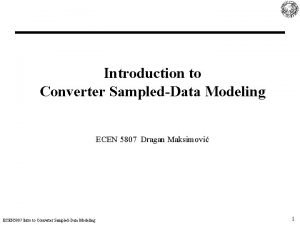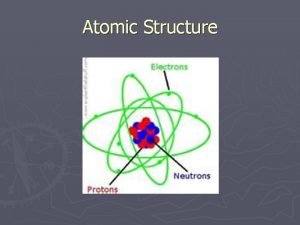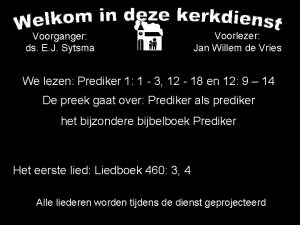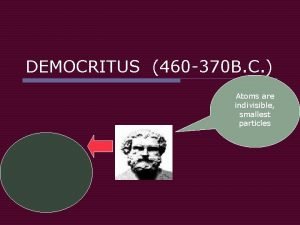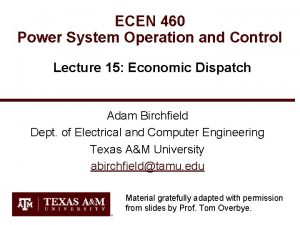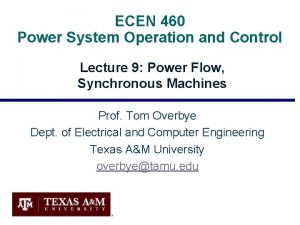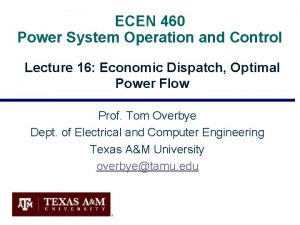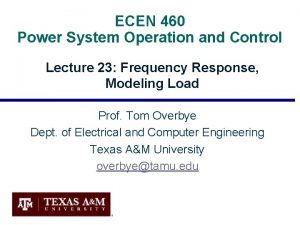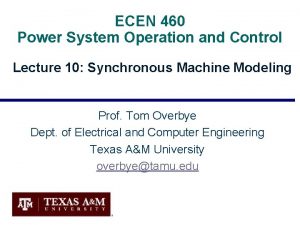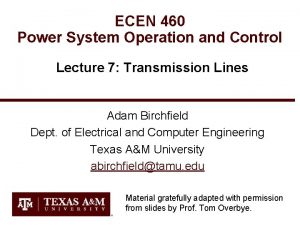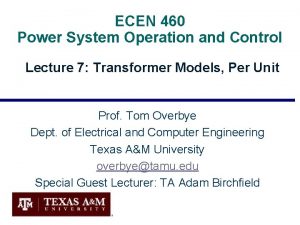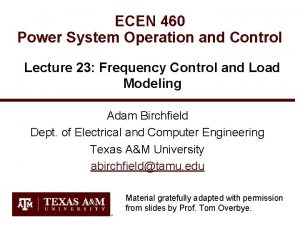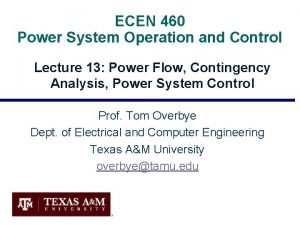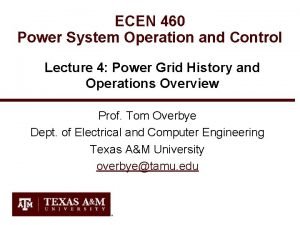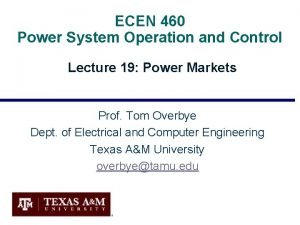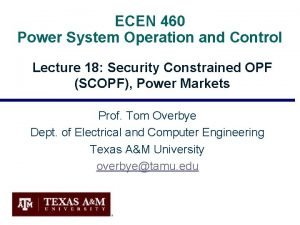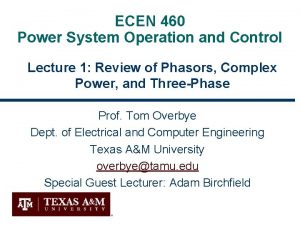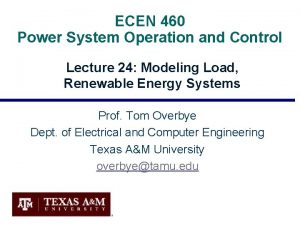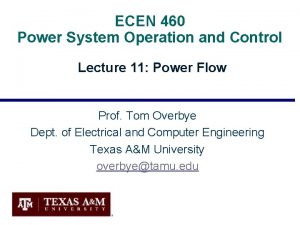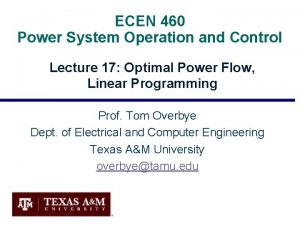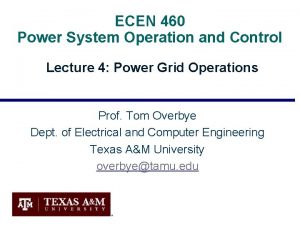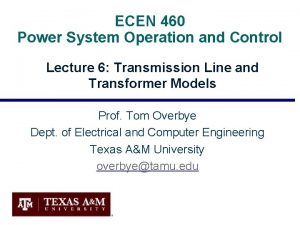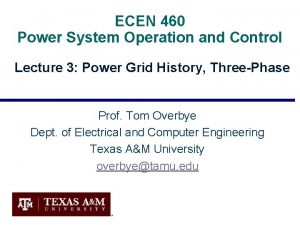ECEN 460 Power System Operation and Control Lecture
































- Slides: 32

ECEN 460 Power System Operation and Control Lecture 6: Synchronous Machine Tests, Transmission Lines Adam Birchfield Dept. of Electrical and Computer Engineering Texas A&M University abirchfield@tamu. edu Material gratefully adapted with permission from slides by Prof. Tom Overbye.

Synchronous machine testing to determine its parameters • These synchronous machine parameters can be determined from two tests (which we’ll do in Lab 3) – – Open-circuit test: measure the machine’s response when there is no load, and the field current is gradually changed Short-circuit test: measure the machine’s response when it is operated at rated speed and its terminals are short-circuited 1

2 Lab 3 and 4 setup • We’ll be using a dc machine (which is speed controllable) to drive a synchronous generator. In lab 4 we’ll be doing open-circuit and shortcircuit tests to determine its parameters In the experiment you’ll be measuring line-to-line values, which are sqrt(3) times the line-to-neutral values

3 Open-circuit characteristic (OCC) • The open-circuit characteristic (OCC) can be derived by gradually changing the field current when operating at a fixed frequency (e. g. , synchronous speed) – • • Hysteresis needs to be considered when making field current adjustments Because there is no stator current, the internal voltage can be directly measured at the terminals We’ll be using phasor values here

4 Short-circuit test • The short-circuit characteristic measures the relationship between the field current and the terminal current • With the model we get • Since usually XS >> RA, so This curve is almost linear since there is little saturation because the fluxes in the machine tend to cancel.

5 Short-circuit test, cont. • However, in doing this test we cannot directly measure EA and of course the terminal voltage is now zero during the short-circuit. • One approach is to approximate it as

6 Short-circuit test, cont. • This approach is accurate up to the point of saturation. An alternative approach is to substitute the equivalent air-gap voltage instead of the VOCC value. – This is commonly called the unsaturated synchronous reactance, Xu The amount of saturation depends on loading; in large generators saturation is explicitly modeled

7 Measuring RA • The winding resistance can be calculated at standstill by applying a small dc voltage to two of the terminals, and then measuring the dc current • Or one could just use an ohmmeter

Operating synchronous machines under load • • • We’ve seen that the terminal voltage of a synchronous machine can be controlled by adjusting its field voltage (and hence field current) Large generators have a number of automatic control systems, including one called an exciter to keep the terminal voltage or other voltage at a specified value Small machines might operate with a constant field current 8

Operating synchronous machines under load with a constant field • If the field voltage and hence field current are assumed constant, and the speed is assumed constant (which in practice would be controlled by a governor), then the internal voltage can be assumed to be constant This is what we’ll be assuming in Lab 4 – • How the voltage varies with loading is then given by 9

Operating synchronous machines under load with a constant field • To help gain insight, we’ll neglect the usually small RA so then – Arbitrarily we can set the angle of VT to zero • If the load has a lagging power factor then internal voltage magnitude is higher • If leading pf then internal voltage is lower than the terminal voltage 10

Operating synchronous machines under load with a constant field • With RA neglected, the power out of the machine is given by 11

12 Example • A 200 k. VA, 480 V (line-to-line), 60 Hz, Yconnected generator with a rated field voltage of 5 A was tested with the following results – – VT, LL = 540 V at rated field current IA, SC = 300 A at rated field current When disconnected, a dc voltage of 10 V is applied to two of the terminals, giving a current of 25 A Find the model

13 Example, cont. • The internal, per phase voltage is • The synchronous reactance at the rated field current is • If we wished to include the impact of RA it would be

14 Example, cont. • Now assume a three-phase, wye-connected load is attached to its terminal with Z = 4 20 Ω. The field current is adjusted so the line-to-line terminal voltage is 480 V and the generator is operated at 60 Hz. What is the internal voltage, and what is the total power delivered to the load? Use XS = 1. 04 Ω. Then repeat with Z = 4 -20 Ω.

15 Example, cont. • With Z = 4 20 Ω • With Z = 4 -20 Ω

16 Quick coverage of dc machines • Prior to widespread use of machine drives, dc motors had a important advantage of easy speed control – Example is a model railroad • On the stator a dc machine has either a permanent magnet or a single concentrated winding – With winding field voltage is Vf and field current is If • Rotor (armature) currents are supplied through brushes and commutator

17 Types of dc machines • If there is a field winding (i. e. , not a permanent magnet machine) then the machine could be connected in the following ways – Separately-excited: Field and armature windings are connected to separate power sources • – – For an exciter, control is provided by varying the field current (which is stationary), which changes the armature voltage Series-excited: Field and armature windings are in series Shunt-excited: Field and armature windings are in parallel

18 Quick coverage of dc machines • In a machine with a field winding the equations are G is a machine constant, wm is its speed • In steady-state these can be simplified to • In a shunt-connected machine, VT = VF so

19 Announcements • Please read Chapters 4 and 5 • Homework 2 is book regular problems 2. 32, 4. 10, 4. 11, 4. 20, and 4. 41. Use appendix A. 4 table as needed to get conductor data. – Due Sept. 20 • Lab 2 will be Friday Sept. 14, Monday Sept. 17, and Tuesday Sept. 18. – Wear long pants and closed-toe shoes • Quizzes will be most Thursdays going forward

20 Transmission Lines • In this class, we give an overview of line and transformer modeling – – • More detailed coverage of some models is in ECEN 459 Our focus is on how to use the models to study power systems Primary Methods for Long Distance Electric Power Transfer – – – overhead ac underground ac overhead dc underground dc other

345 k. V+ Transmission Growth at a Glance 21

345 k. V+ Transmission Growth at a Glance 22

345 k. V+ Transmission Growth at a Glance 23

345 k. V+ Transmission Growth at a Glance 24

345 k. V+ Transmission Growth at a Glance 25

26 HVDC Lines in North America http: //www. grainbeltexpresscleanline. com/site/page/history_of_hvdc_transmission

27 Line Conductors • Typical transmission lines use multi-strand conductors • ACSR (aluminum conductor steel reinforced) conductors are most common. A typical Al. to St. ratio is about 4 to 1. • AAC (all aluminum conductors) are lighter but have less strength; used in urban areas with shorter spans • Copper is heavier, but has better conductance; used in cables where weight is not an issue

28 Line Conductors, cont’d • Total conductor area is given in circular mils. One circular mil is the area of a circle with a diameter of 0. 001 = 0. 00052 square inches • Example: what is the area of a solid, 1” diameter circular wire? Answer: 1000 kcmil (kilo circular mils) • Because conductors are stranded, the equivalent radius must be provided by the manufacturer. In tables this value is known as the GMR and is usually expressed in feet.

29 Line Resistance

30 Line Resistance, cont’d • Because ac current tends to flow towards the surface of a conductor, the resistance of a line at 60 Hz is slightly higher than at dc. • Resistivity and hence line resistance increase linearly as conductor temperature increases (changes is about 0. 4% per degree C) – In some locations conductor temperatures can vary by up to 100 C! • Because ACSR conductors are stranded, actual resistance, inductance and capacitance needs to be determined from tables.

Variation in Line Resistance Example 31
 Ecen 460
Ecen 460 Ecen 460
Ecen 460 Ecen 5817
Ecen 5817 Ecen 621
Ecen 621 Ecen 621
Ecen 621 Ecen 621
Ecen 621 Ecen 489
Ecen 489 Ecen 5797
Ecen 5797 Ecen 5807
Ecen 5807 Power system dynamics and stability lecture notes
Power system dynamics and stability lecture notes Power system dynamics and stability lecture notes
Power system dynamics and stability lecture notes Power system analysis lecture notes
Power system analysis lecture notes 01:640:244 lecture notes - lecture 15: plat, idah, farad
01:640:244 lecture notes - lecture 15: plat, idah, farad Real power formula
Real power formula 460 bc atomic structure
460 bc atomic structure Khrihfa hlabu 460
Khrihfa hlabu 460 460 punkte abitur
460 punkte abitur Luxury sports car rental houston
Luxury sports car rental houston Cis460
Cis460 Democritus atom model
Democritus atom model Gezang 179
Gezang 179 Who discovered roentgenograms
Who discovered roentgenograms 271 en yakın onluğa yuvarlama
271 en yakın onluğa yuvarlama Sen 460
Sen 460 Multis complex shd 460
Multis complex shd 460 St460ts
St460ts When was hippocrates born
When was hippocrates born Hs 460
Hs 460 Democritus 460 bc
Democritus 460 bc Introduction to inventory management
Introduction to inventory management Power angle curve in power system stability
Power angle curve in power system stability Power semiconductor devices lecture notes
Power semiconductor devices lecture notes Switch mode power supply lecture notes
Switch mode power supply lecture notes
